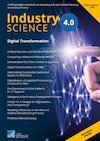Search


Bibtex
Cite as text
@Article{Fischer+Grüger+Woll,
Cite-key = "Fischer2023Mod",
Year= "2023",
Number= "1",
Volume= "Industry 4.0 Science 39",
Pages= "80-87",
Journal = "Industry 4.0 Science",
Title= "Modeling Influences on the Wire Arc Additive Manufacturing Process",
Author= "Tim Sebastian Fischer, Lennart Grüger and Ralf Woll, Brandenburg University of Technology Cottbus-Senftenberg (BTU)",
Doi= "https://doi.org/10.30844/I4SE.23.1.80",
Abstract= "Wire Arc Additive Manufacturing (WAAM) is an additive manufacturing process which produces metallic components on the basis of arc welding. ISO/ASTM 52900 describes additive manufacturing as a process that creates components layer by layer from 3D model data. The basic equipment required
includes a welding device, introducing the energy necessary for melting the metal wire, and a guiding machine, which traces the specified geometry of the component. Applications for WAAM include rapid prototyping and tooling, direct manufacturing and additive repair. The main advantages of the process are its cost-effective plant technology and high deposition rate. The
disadvantages of the process are the lack of process stability and exact repeatability. This article is intended to provide a clear overview of the WAAM manufacturing process, and to address its complex interactions.",
Keywords= "process visualization, Additive
Manufacturing, Wire Arc Additive
Manufacturing, WAAM, Structured Analysis and Design Technique, SADT, welding, manufacturing, metal components, slicing, arc welding, deposition rate, machining centers, wire feed rate",
}
Tim Sebastian Fischer, Lennart Grüger and Ralf Woll, Brandenburg University of Technology Cottbus-Senftenberg (BTU)(2023): Modeling Influences on the Wire Arc Additive Manufacturing Process. Industry 4.0 Science 391(2023), S. 80-87. Online: https://doi.org/10.30844/I4SE.23.1.80 (Abgerufen 23.12.25)
Open Access
Abstract
Abstract
Wire Arc Additive Manufacturing (WAAM) is an additive manufacturing process which produces metallic components on the basis of arc welding. ISO/ASTM 52900 describes additive manufacturing as a process that creates components layer by layer from 3D model data. The basic equipment required includes a welding device, introducing the energy necessary for melting the metal wire, and a guiding machine, which traces the specified geometry of the component. Applications for WAAM include rapid prototyping and tooling, direct manufacturing and additive repair. The main advantages of the process are its cost-effective plant technology and high deposition rate. The disadvantages of the process are the lack of process stability and exact repeatability. This article is intended to provide a clear overview of the WAAM manufacturing process, and to address its complex interactions.
Keywords
Schlüsselwörter
process visualization, Additive Manufacturing, Wire Arc Additive Manufacturing, WAAM, Structured Analysis and Design Technique, SADT, welding, manufacturing, metal components, slicing, arc welding, deposition rate, machining centers, wire feed rate
References
Referenzen
[1] DIN EN ISO/ASTM 52900: Additive Fertigung – Grundlagen – Technologie (ISO/ASTM DIS 529000:2018-7), DIN Deutsches Institut für Normung e.V., Berlin.
[2] Schmid, C.: Konstruktive Randbedingungen bei Anwendung des WAAM-Verfahrens. In: Lachmayer, R.; Rettschlag, K.; Kaierle, S. (ed): Konstruktion für die Additive Fertigung. Berlin Heidelberg 2020.
[3] Lachmayer, R.; Lippert, R. B.: Entwicklungsmethodik für die Additive Fertigung. Berlin Heidelberg 2020.
[4] Chunyang, X.; Zengxi P. et al.: A review on wire arc additive manufacturing: Monitoring, control and a framework of automated system. In: Journal of Manufacturing Systems, p. 1.
[5] Tolk, A.; Diallo, S. Y. et al.: Effective and scalable uncertainty evaluation for large-scale complex system applications. In: 2014 Winter Simulation Conference.
[6] Singh, S. R.; Khanna, P.: Wire arc additive manufacturing (WAAM): A new process to shape engineering materials. In: Materials Today 44 (2021): Proceedings, pp. 118-128.
[7] Lockett, H.; Ding, J. et al.: Design for Wire + Arc Additive Manufacture: design rules and build orientation selection. In: Journal of Engineering Design 28 (2017) 7-9, pp. 568-598.
[8] Jin, W.; Zhang, C. et al.: Wire Arc Additive Manufacturing of Stainless Steels: A Review. In: Applied Sciences 10 (2020) 5, p. 1563.
[9] DIN-Fachbericht ISO/TR 581: Schweißbarkeit – Metallische Werkstoffe – Allgemeine Grundlagen; Deutsche Fassung ISO/TR 581:2005, DIN Deutsches Institut für Normung e.V., Berlin.
[10] Huang, J.; Qin, Q. et al.: A dynamic slicing algorithm for conformal additive manufacturing. In: Additive Manufacturing Vol. 51 (2022).
[11] Xiong, Y.; Wen, D. et al.: Effect of interlayer temperature on microstructure evolution and mechanical performance of wire arc additive manufactured 300M steel. In: Materials Science and Engineering: A, 831 (2021).
[12] Kyvelou, P. et al.: Mechanical and microstructural testing of wire and arc additively manufactured sheet material. In: Materials & Design 192 (2020), pp. 108675.
[13] Singh, S.; Sharma, S. et al.: A review on process planning strategies and challenges of WAAM. In: Materials Today: Proceedings 47 (2021), pp. 6564-6575.
[14] Pattanayak, S.; Sahoo, S.: Gas metal arc welding based additive manufacturing—a review. In: CIRP Journal of Manufacturing Science and Technology 33 (2021).
[15] Schuler, V.; Twrdek, J.: Praxiswissen Schweißtechnik, 6th edition. Wiesbaden 2019.
[16] Gibson, I.; Rosen, D.; Stucker, B.; Khorasani, M.: Additive Manufacturing Technologies, 3th edition. Cham 2021.
[17] Lachmayer, R.; Lippert, R. et al.: Additive Serienfertigung. Berlin 2018.
[18] Richter, A.; Scheck, M. et al.: Erfassung der Schmelzbadfläche mit Korrektur der Perspektive zur Prozessregelung eines Wire and Arc Additive Manufacturing, In: tm – Technisches Messen 89 (2022) 7-8, pp. 525-533.
[19] VDI-3405: Blatt 2 Additive Fertigungsverfahren Strahlschmelzen metallischer Bauteile Qualifizierung, Qualitätssicherung und Nachbearbeitung, Verein Deutscher Ingenieure e.V. Berlin (Fall 2013).

 English
English